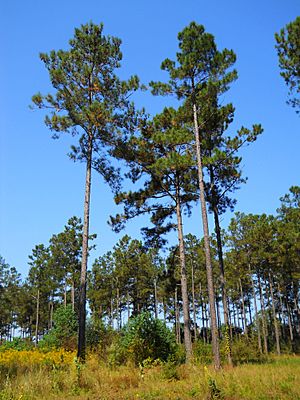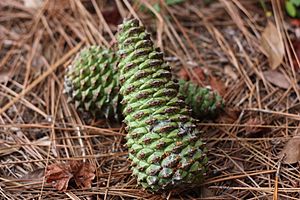Loblolly pine facts for kids
Quick facts for kids Loblolly pine |
|
|---|---|
 |
|
| Characteristic appearance of loblolly pines, south Mississippi, USA | |
| Conservation status | |
| Scientific classification | |
| Genus: |
Pinus
|
| Species: |
taeda
|
 |
|
| Natural range of loblolly pine | |
The loblolly pine (scientific name: Pinus taeda) is a type of pine tree. It grows naturally in the Southern United States, from East Texas to Florida, and up to southern New Jersey. The wood from this tree is known as a 'southern yellow pine'.
It's the second most common tree in the United States, right after the red maple. This pine is super important for the lumber industry in the Southeastern U.S. People call it 'loblolly' because it often grows in wet, low-lying areas, like swamps.
The loblolly pine was the very first type of pine tree to have its entire genome (all its DNA) mapped out. For a while, it had the biggest genome ever mapped! Its genome is huge, with 22 billion 'building blocks' of DNA. That's seven times bigger than a human genome! Later, in 2018, the axolotl took its place with an even bigger genome. The loblolly pine became the official state tree of Arkansas in 1939.
Contents
What Loblolly Pines Look Like
Loblolly pines can grow very tall, usually between 30 to 35 meters (about 100 to 115 feet) high. Their trunks can be from 0.4 to 1.5 meters (about 1.3 to 5 feet) wide. Some special trees can even reach 50 meters (164 feet) tall, making them the tallest of the southern pines.
Their needles grow in bundles of three. They are sometimes twisted and are about 12 to 22 centimeters (5 to 9 inches) long. This length is in the middle for southern pines. They are shorter than longleaf pine needles but longer than shortleaf pine needles. These needles usually stay on the tree for up to two years. This is why the tree stays green all year round.
Even though some needles fall off all year because of bad weather or bugs, most needles drop during autumn and winter. This happens in their second year. The pine cones start green and turn pale brown when they are ready. They are 7 to 13 centimeters (3 to 5 inches) long when closed. When they open, they are 4 to 6 centimeters (1.5 to 2.5 inches) wide. Each scale on the cone has a sharp spine that is 3 to 6 millimeters (about 0.1 to 0.2 inches) long.
The tallest loblolly pine known today is 51.4 meters (169 feet) tall. The largest one, by volume, is 42 cubic meters (1,483 cubic feet). Both of these amazing trees are found in Congaree National Park.
Name and Classification
The name "loblolly" comes from old words meaning "thick porridge" or "mudhole." This name fits because these pines often grow in muddy, low-lying, or swampy areas. Loblolly pines grow very well in acidic clay soil. This type of soil is common across the Southern United States. Because of this, you can often find large groups of them in rural areas.
Other old names for this tree are rarely used now. These include "oldfield pine" because it was one of the first trees to grow in fields that were no longer farmed. It was also called "bull pine" because of its large size. Sometimes, it was called "rosemary pine" because of its unique smell.
For its scientific name, Pinus is the Latin word for pines. taeda means "resinous wood," which refers to the sticky sap found in the wood.
Loblolly Pine in Nature
Loblolly pines grow very quickly, even compared to other fast-growing southern pines. Their yellowish, sticky wood is highly valued for lumber. It is also used to make wood pulp for paper. Because they grow so fast and are so useful, these trees are often grown in large tree farms.
In some parts of the Deep South, loblolly pines have become very common. This happened after people started stopping wildfires. Before, these areas were mostly covered by longleaf pine and slash pine.
You can find isolated groups of loblolly pines in places like the Lost Pines Forest in Bastrop, Texas. They grow there on sandy, acidic soil. This is unusual because the surrounding areas have alkaline clay, which is not good for pine trees.
Scientists have studied loblolly pines to see how they react to changes in the air. One study showed that higher levels of carbon dioxide in the air might help these trees survive ice storms better.
Famous Loblolly Pines
The famous "Eisenhower Tree" was a loblolly pine. It stood on the 17th hole of Augusta National Golf Club. U.S. President Dwight D. Eisenhower was a member of the club. He hit the tree with his golf ball so many times! In 1956, he even suggested cutting it down. The club chairman quickly ended the meeting to avoid saying no to the President. Sadly, in February 2014, a big ice storm badly damaged the tree. Experts said it couldn't be saved, so it was removed.
Another notable tree is the "Morris Pine" in southeastern Arkansas. This tree is over 300 years old! It has a trunk that is 142 centimeters (56 inches) wide and stands 35.7 meters (117 feet) tall.
Loblolly pine seeds even traveled to space! They were carried aboard the Apollo 14 flight. When they returned, these seeds were planted in different places across the U.S., including the grounds of the White House. Many of these special "moon trees" are still alive today.
Loblolly Pine Genome
Pines are the most common type of conifer tree. There are over 100 different species in the Pinus group. Mapping their genomes used to be a huge challenge because they are so big and complex. But the loblolly pine became the first conifer to have its entire genome mapped. For a while, it was the largest genome ever put together, until the axolotl genome was mapped in 2018.
The loblolly pine genome has 22.18 billion 'building blocks' of DNA. This is more than seven times the size of a human genome! Conifer genomes are known to have a lot of repeating DNA sections. In the loblolly pine, these repeating parts make up 82% of its genome. For comparison, in humans, only about 50% of the genome is made of repeating parts. Scientists believe the loblolly pine has about 50,172 genes. Many of these genes are duplicates, meaning they are copies of other genes.
See also
 In Spanish: Pino taeda para niños
In Spanish: Pino taeda para niños





